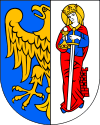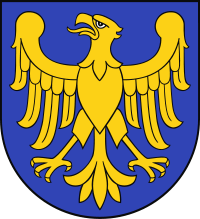Ruda Śląska
Ruda Śląska [ˈruda ˈɕlɔ̃ska] (![]()
Ruda Śląska | |
|---|---|
 Niedurnego Street in Ruda Śląska | |
 Flag  Coat of arms | |
 Ruda Śląska  Ruda Śląska | |
| Coordinates: 50°15′46″N 18°51′13″E | |
| Country | Poland |
| Voivodeship | |
| County | city county |
| Established | 13th century |
| Town rights | 1959 |
| Government | |
| • Mayor | Grażyna Dziedzic |
| Area | |
| • City | 77.73 km2 (30.01 sq mi) |
| Population (31 December 2019) | |
| • City | 137,360 |
| • Urban | 2,746,000 |
| • Metro | 4,620,624 |
| Time zone | UTC+1 (CET) |
| • Summer (DST) | UTC+2 (CEST) |
| Postal code | 41–700 to 41–718 |
| Area code(s) | +48 32 |
| Car plates | SRS, SL |
| Website | http://www.rudaslaska.pl/ |
It has been part of the Silesian Voivodeship since its formation in 1999. Previously, it was in Katowice Voivodeship, and before then, part of the Autonomous Silesian Voivodeship. Ruda Śląska is one of the cities in the Katowice urban area (population 2.7 million) and within the greater Silesian metropolitan area (population 5,294,000).[2] The population of the city is 137,360 (December 2019).[1]
History

A large village is known to have existed at the location of the present day city center in 1243. The city name appears to indicate the awareness and perhaps exploitation of ores from early times.
The area underwent rapid industrialization (coal, steel, zinc) in the 19th and the beginning of 20th century. However, it remained a cluster of industrial settlements and villages until the 1950s, when it was administratively united. However, it never developed into a truly unified city.
After the fall of communism in 1989, the significant heavy industry was largely scaled down or restructured. The area has been transforming to a service-based economy. The well-known still operating coal mine is "Halemba".
Since 2007, Ruda Śląska has been a member of the Upper Silesian Metropolitan Union, the largest legally recognized urban area in Poland.
Transport and infrastructure
Significant roadways are Highway A4 and the Drogowa Trasa Średnicowa. There are several small railway stations, mainly on the line Katowice-Gliwice.
Since 1950, Ruda Śląska is the site of a transmission facility, which was used from 1950 to 1988 for medium-wave radio broadcasting.
Higher education
The neighboring cities of Katowice and Gliwice are large academic centers. Ruda Śląska is a seat of the Higher Academy of Commerce (Wyższa Szkoła Handlowa).
Sports
- Zgoda Ruda Śląska – women's handball team playing in Polish Ekstraklasa Women's Handball League
- Rugby Club IGLOO Ruda Śląska – men's rugby team playing in Polish Ekstraliga Rugby Seven's
Subdivisions
The city of Ruda Śląska is divided into following subdivisions:
|
 |
Notable people
- Karl Godulla (1781–1848), German industrialist
- Günter Bialas (1907–1995), German composer
- Paweł Cyganek (1913–1995), footballer
- Ernest Pohl (1932–1995), footballer
- Erwin Wilczek (born 1940), footballer
- Marcin Baszczynski (born 1977), footballer
- Otylia Jędrzejczak (born 1983), Olympic gold medalist and world record-holder in swimming
- Kasia Moś (born 1987), singer and songwriter, represented Poland at the Eurovision Song Contest 2017
- Artur Sobiech (born 1990), footballer
Ruda Śląska is the largest population center in Poland never to have been visited by Lech Wałęsa. This is shown on a brass plaque on the side of the ratusz (town hall).
Twin towns – sister cities
Ruda Śląska is twinned with:[3]





References
- "Local Data Bank". Statistics Poland. Retrieved 27 June 2020. Data for territorial unit 2472000.
- European Spatial Planning Observation Network (ESPON) "Archived copy". Archived from the original on 28 July 2009. Retrieved 28 March 2009.CS1 maint: archived copy as title (link)
- "Miasta partnerskie". rudaslaska.pl (in Polish). Ruda Śląska. Retrieved 10 March 2020.
| Wikimedia Commons has media related to Ruda Śląska. |
